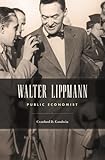Walter Lippmann : Public Economist / Craufurd D. Goodwin.
Material type: TextPublisher: Cambridge, MA : Harvard University Press, [2014]Copyright date: ©2014Description: 1 online resource (370 p.)Content type:
TextPublisher: Cambridge, MA : Harvard University Press, [2014]Copyright date: ©2014Description: 1 online resource (370 p.)Content type: - 9780674368132
- 9780674735750
- 330.156092 23
- HB119.L56
- online - DeGruyter
- Issued also in print.
| Item type | Current library | Call number | URL | Status | Notes | Barcode | |
|---|---|---|---|---|---|---|---|
 eBook
eBook
|
Biblioteca "Angelicum" Pont. Univ. S.Tommaso d'Aquino Nuvola online | online - DeGruyter (Browse shelf(Opens below)) | Online access | Not for loan (Accesso limitato) | Accesso per gli utenti autorizzati / Access for authorized users | (dgr)9780674735750 |
Browsing Biblioteca "Angelicum" Pont. Univ. S.Tommaso d'Aquino shelves, Shelving location: Nuvola online Close shelf browser (Hides shelf browser)

|

|

|

|

|

|

|
||
| online - DeGruyter Too Big to Jail : How Prosecutors Compromise with Corporations / | online - DeGruyter Death in the Congo : Murdering Patrice Lumumba / | online - DeGruyter God’s Planet / | online - DeGruyter Walter Lippmann : Public Economist / | online - DeGruyter American Passage : The Communications Frontier in Early New England / | online - DeGruyter Makers of Modern Asia / | online - DeGruyter Native Tongues : Colonialism and Race from Encounter to the Reservation / |
Frontmatter -- Contents -- Preface -- Note On Citations And Abbreviations -- Introduction -- 1 The Making Of A Public Economist -- 2 Building Intellectual Community -- 3 "You Can Always Tell A Harvard Man" -- 4 Recovery -- 5 Keynesian Conversion -- 6 Reform I: Redistribution -- 7 Reform II: Monopoly -- 8 "Regenerated Liberalism" -- 9 War -- 10 Peace -- 11 The Economy of the Postwar World -- 12 The Good Economy -- Draft of Declaration of Principles, 1936 (WLPIII F640) -- Columns by Walter Lippmann -- References -- Index
restricted access online access with authorization star
http://purl.org/coar/access_right/c_16ec
Walter Lippmann was the most distinguished American journalist and public philosopher of the twentieth century. But he was also something more: a public economist who helped millions of ordinary citizens make sense of the most devastating economic depression in history. Craufurd Goodwin offers a new perspective from which to view this celebrated but only partly understood icon of American letters. From 1931 to 1946 Lippmann pursued a far-ranging correspondence with leading economic thinkers: John Maynard Keynes, Lionel Robbins, Friedrich Hayek, Henry Simons, Adolf Berle, Frank Taussig, and others. Sifting through their divergent views, Lippmann formed his own ideas about economic policy during the Great Depression and shared them with a vast readership in his syndicated column, Today and Tomorrow. Unemployment, monetary and fiscal policy, and the merits and drawbacks of free markets were just a few of the issues he helped explain to the public, at a time when professional economists who were also skilled at translating abstract concepts for a lay audience had yet to come on the scene. After World War II Lippmann focused on foreign affairs but revisited economic policy when he saw threats to liberal democracy. In addition to pointing out the significance of the Marshall Plan and the World Bank, he addressed the emerging challenge of inflation and what he called "the riddle of the Sphinx": whether price stability and full employment could be achieved in an economy with strong unions.
Issued also in print.
Mode of access: Internet via World Wide Web.
In English.
Description based on online resource; title from PDF title page (publisher's Web site, viewed 30. Aug 2021)


